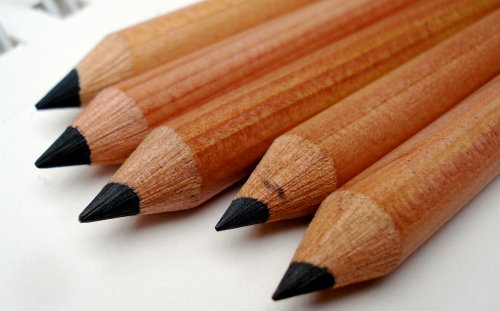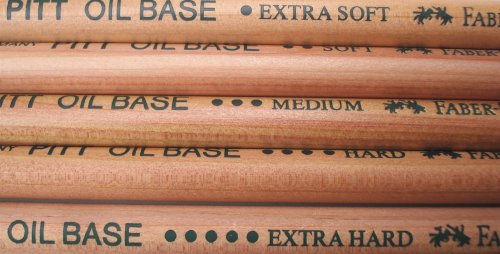
Yet Another Mike had mentioned these pencils a couple of months ago, and I recalled the comment when I recently found some for sale. Thanks, Mike.
From Faber-Castell, we have a slightly different type of pencil. It uses oil rather than wax as the binding agent.
The advantage is that this pencil type creates lightfast marks that don’t require a fixative.
The three asterisks on the pencil indicate the marks will last over one hundred years in museum conditions!
It also has some interesting properties – sharpening to a point is easy, and that point stays strong – unlike many alternate formulation (pastel, charcoal, etc.) artist-oriented pencils. The pencils are also very smooth and manageable in the hand.

They are offered in five degrees, Extra Soft through Extra Hard.

The five degrees on Strathmore Windpower Sketch 89g/m2 paper:

The pencils are attractive, priced no more than regular graphite pencils, and definitely capable. Do you use them? If so, why did you choose them?

I have not tried these particular Faber Castell pencils, but I suspect that their properties are probably similar to the oil-based Cretacolor Nero 5.6 mm drawing leads. Thus, they might also be a good choice for sketching waterproof outlines that resist smudging and lay down rich dark marks fairly smoothly. They do not seem to be a common regular item offered by vendors in the US. Utrecht seems to be the only retailer to have them listed online by the box of 12 pencils.
As a painter, using oil paints, this pencil
is a great alternative to graphite or charcoal
for drawing up onto canvas. It sits very well
under the turpentine/oil mix tonal underpainting
that is usually applied before thicker painting
in the final stages of making works in oils.
It’s a great pencil.
An old faithful favourite.
A couple of local stores (in Central Florida) carry these in open stock, but I haven’t really tried them yet. From the couple of strokes I took on scrap in the store, I seem to remember it having a consistency similar to that of General’s Primo Euro charcoal pencils. Smoother than normal charcoal pencils, very black, and relatively smudge-resistant. Does anyone have any idea what the core is made of in these pencils? It says Oil-Base on the barrel, but doesn’t indicate whether it’s charcoal, graphite, or what.
Hey, I’m one of the Mikes (obviously), I think there are at least two others that have posted here with me on another thread. I don’t remember if I was the one who suggested the Pitt Pastel to you. I do however have some of these in my collection. Not that I’m a collector, I’m just a hobbyist that’s trying to learn how to draw.
They’re great pencils, they’re made from an oil based graphite. I don’t draw with them that often however. Mine came in a blister pack with some other Faber Castell products. I only bought it because of the Pitt pastels. If I saw these being sold in open stock I’d definitely buy a box.
One last thing if you’d like to see how one great artist/art instructor uses these pencils then go read this discussion on cartooning. The blog is written by Pete Emslie an instructor teaching at Sheridan College. http://cartooncave.blogspot.com/2007/11/cartoon-caveman-at-work.html
Oh wait, I have one more thing to say. I thought of this because of Jason’s question. Faber Castell also makes charcoal pencils which for some odd reason has PITT PASTEL written on them. This is very confusing because they are a charcoal pencil and they look very similar to the oil graphite pencil. They do have their differences though, so it’s possible to tell them apart.
The Pitt charcoal pencils have the ends of the pencil fully dipped in black paint, and have PITT PASTEL written on them as well, they also have asterisks on them to represent the hardness of the charcoal.
The oil based graphite pencils only have the very tip dipped in black paint, just like in the picture up above. The Pitts with the oil based graphite say PITT OIL BASED, as well as having three dots, and a description of the graphite, soft, medium, hard, etc. Both pencils have the same natural wood finish.
So I hope I helped clear up that confusion.
For number of years I have used the Faber-Castell PITT OIL BASE red pencil, marked ROTEL/SANGUINE to draw with. It’s a delight, doesn’t smear, marked with the 3 stars, glad to learn what they mean.
You’re welcome! I go to one of the Art Institutes main usage of these is 2d animation: Our school uses 2D to ingrain in us the principles of animation so that we ca be better 3d animators, as it’s technically a 3D program. What we’re recommended to use Prismacolor’s col-erase pencils, since they’re supposed to be as bold as a grease pencil, but they were too hard for me. So I kept trying anything the art stores had to offer until I found something softer and slightly erasable, yet didn’t smudge so easily (which is hard to tell because the paper that the store has to sample pencils smudges everything!). So far I’ve settled to using the PITT pencils, but I’ve also found a similar (competing?) product by generals called “Generals ‘Wet-Proof’ U.S.A. -881.” They’re almost indistinguishable in terms of their properties, but it only comes in a single grade. I also use the “PITT OIL BASE” for general drawing purposes. I didn’t see any color variations in any stores yet, now I’ll be on the hunt for them as well…
NYCentral Art carries them.
I have used these. They are still smudgy, just not dusty like regular charcoal. I like them a lot for their rich color. They are my number one “charcoal pencil” choice.
This is my new favorite pencil. It’s firm enough to hold a point pretty nicely. It is dark black, instead of silvery like graphite. It will smudge. I like the flexibility to use a tortilion to even out a lightly applied area to a light grey (filling in the grain of the paper). I can also make very dark black with some pressure. It semi-erases. I got a 3-pack of the black medium, black extra-soft, and sanguine at a Utrecht store. The sanguine is a bit too light for my taste (not as dark as my conte stick) so I decided I’d get more of just the soft black. The singles are back ordered at the Utrecht site. For some reason, it’s hard to do a search on the Faber Castell site, so I’ll supply the entire link here for anyone else interested in a 12-pack: http://artgraphic.fabercastell.com/products/product_detail.aspx?id=EFE00390C6BF49DF9927991115C617F2
Bekah, thanks for sharing your findings. It sounds like you enjoy ‘classical’ media.
I used these as a carpenter to mark on wet wood, works great!
I think graphite is not used on these pencils, the pigment used is most probably obtained from charcoal, carbon black or bone char (aka bone black). The later two provide an even denser black than charcoal.
http://en.wikipedia.org/wiki/Carbon_black
http://en.wikipedia.org/wiki/Bone_char
R.
A few more high quality oil based black pencils that may be worth to try.
– Koh-I-Noor Gioconda Negro.
– Cretacolor Nero 350 (also available in 5.6mm leads).
– Derwent Drawing (also available in black).
R.
love this pencil..
is there a white one?
I also wish there were a white one. I discovered the pencil in Japan several years ago and after bonding with it for my black and white drawings it was discontinued by Faber Castell. So I contacted them and had to place a custom order of over a hundred pencils. I now see that they are available again. I use the “soft” on Bristol Smooth Surface paper and love the ease of my line–just flows. I can also make it super dark with a thin coat of Cold Wax.
I have recently started using these after a long break from sketching. The ease at which intensity of black can be controlled with adjustments of pressure and repetition is very satisfying. The medium holds together well when sharpening and the point lasts well enough to work in finer detail. So far the only paper I have used then on is a textured schoellershammer on which the grain was easily saturated where the most intense black was required.
Under lockdown now, but I will definitely try and get a stock as soon as my local supplier in Hermanus, South Africa is opened for business.